Today, 3rd of March, is World Wildlife Day (as proclaimed by the United Nations in December 2013). So I decided to make today’s post one on the theme of dark tourism and animals!
Now, in what ways can animals be ‘dark’? Well, for one thing it could be because a kind of animal may be dangerous to humans. And indeed quite a few animals are (while most are not – and generally humans pose a much greater danger to animals than the other way round!), although perceptions are often a bit skewed. Many people will think of big cats like lions first when they think of dangerous animals. Consider these determined-looking lionesses:
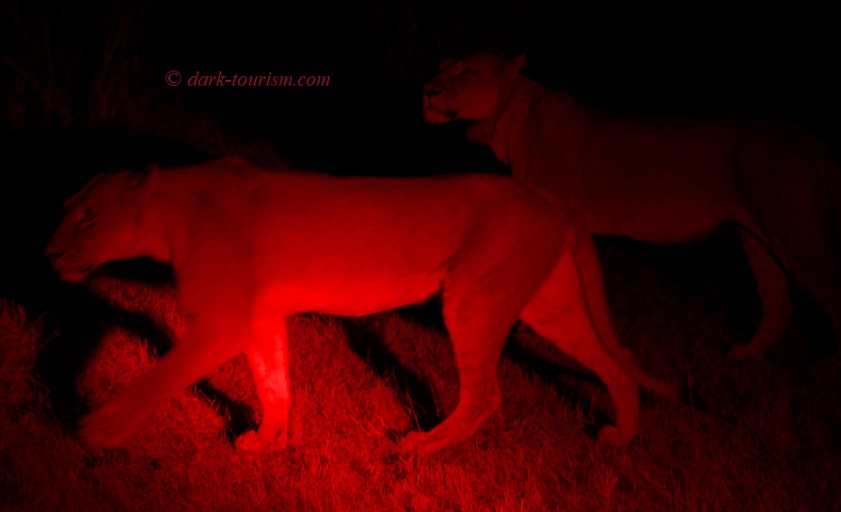
This photo was shot at the end of an evening safari near Victoria Falls in Zimbabwe in 2018. The red light was from the ranger’s torch light – apparently the animals don’t mind red light as much as they would white light. It may indeed have been a daft thing to have got out of the jeep at this point, but generally humans are not really on a lion’s menu, so to speak.
A much more dangerous animal to humans, and the species that’s indeed responsible for the highest number of human deaths resulting from wild animal encounters in Africa, is the hippo. Here are a couple that I photographed from a boat on the Zambezi River, also in Zimbabwe (same 2018 trip):
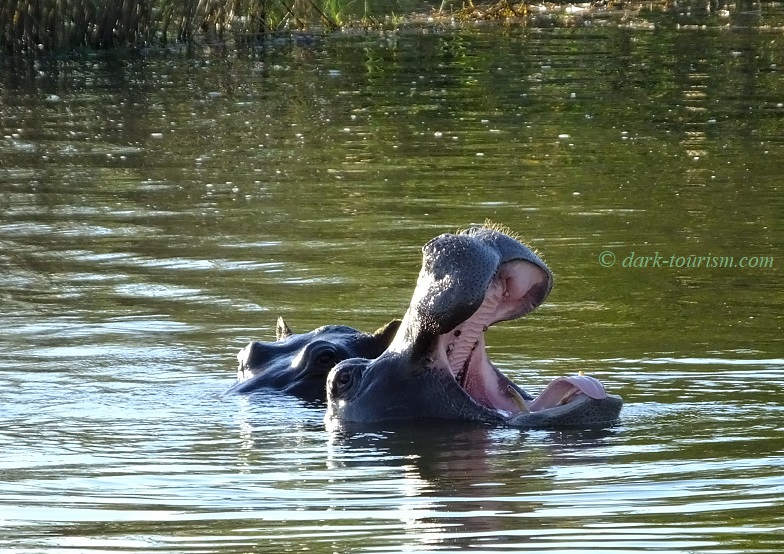
These jaws are surely impressive, but viewing these creatures from a large boat is perfectly safe. The problems with hippos arise mostly when they are out of the water grazing on land, usually at dusk, and when a careless human steps between them and the water. Apparently that makes hippos so irate that they charge. And as my safari ranger in the Sabi Sabi private reserve in South Africa put it: they’d just snap you in half.
Not quite as irritable as hippos but also of a certain danger level can be crocodiles, such as this big mugger I photographed in India (December 2016) on a boat safari on the Chambal River.
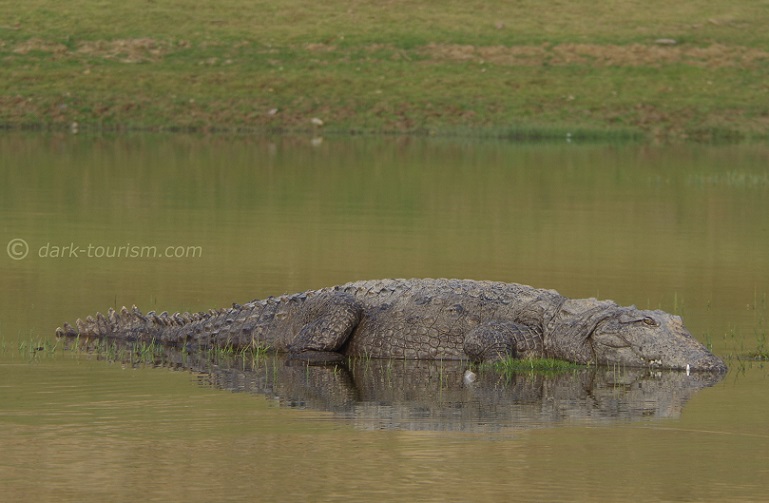
A danger of a different sort comes from poisonous animals, such as some insects and some sea creatures, but mostly we associate poisonous bites with snakes. And the American rattlesnake has a particularly bad reputation. As if to underscore that, this rattlesnake is even perched on a prickly cactus:
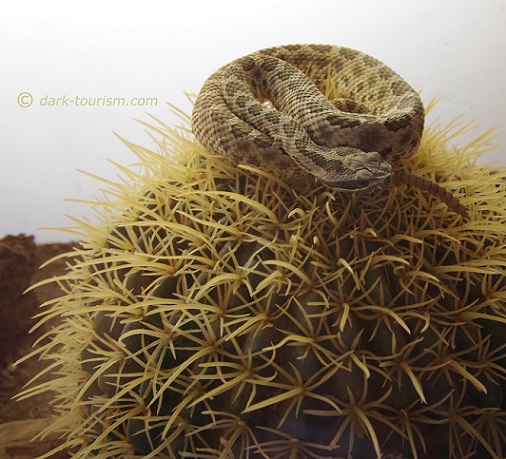
This photo was taken in perfectly safe conditions, though, as this snake was behind glass, namely in the Rattlesnake Museum in Albuquerque, New Mexico, USA.
An animal that is dangerous both because of its toxic bite and because of its physical strength is the rare Komodo dragon, which is found on only a few islands in the Indonesian archipelago (Komodo being the main one).
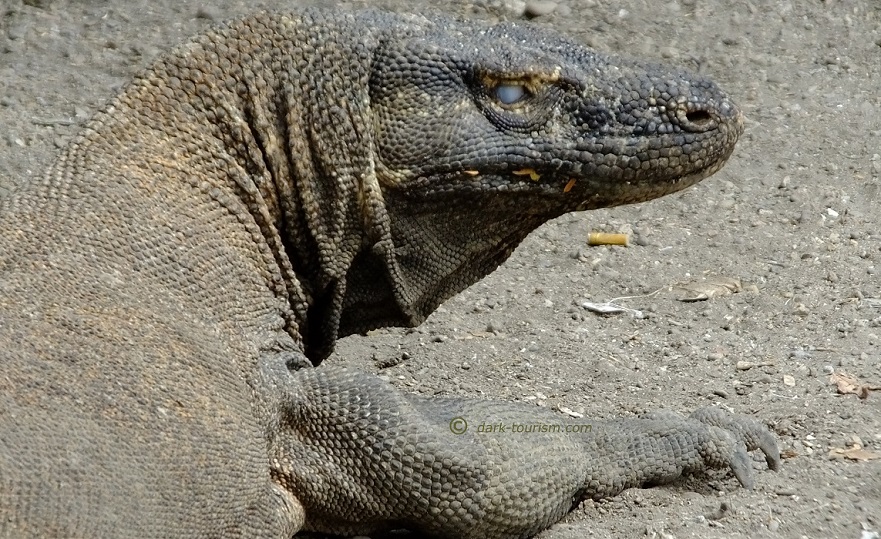
These largest lizards on Earth are a bit of an evolutionary enigma. That’s because they ambush their victims, mostly deer or buffalo (but sometimes also unwary humans), administer one bite but then let their prey go. The unlucky wounded creature will then slowly die from sepsis caused by the bite. The riddle here is that the dragon that finds the deceased prey and sets about devouring it need not be the same one that did the biting. The biter may in fact get no reward at all. That goes against evolutionary principles, but here it apparently works, as the area is so limited and delineated that it balances out for the entire population. Anyway, seeing these fierce creatures on Komodo and Flores was definitely a highlight of my Indonesia trip in 2014!
Sometimes a species may have a very bad reputation amongst humans but without that actually being deserved, and the prime example for this has to be hyenas.
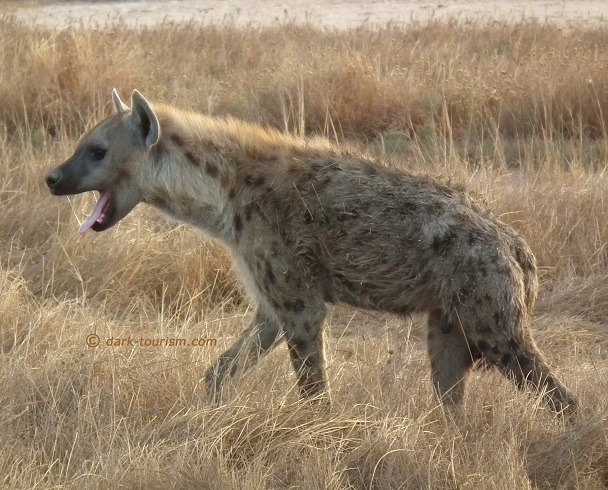
I’ve seen wild hyenas in two different locations. The first time was in Senegal in 2013 and in safari style, though not from a jeep but from a horse-drawn cart. This big hyena was just getting up and yawning as we approached, possibly disturbed by our arrival, but then just slowly trotted off perfectly relaxed.
The second time was in Ethiopia a good fourteen months ago on my last trip out of Europe just before the coronavirus pandemic started. And this encounter was very different. It was in the ancient city of Harar in central Ethiopia. While hyenas are vilified almost everywhere else, here in Harar they are revered and deeply woven into the local culture and folklore. Most remarkably, at two sites just outside the walls of the medieval Old Town clans of wild hyenas have been habituated enough to come to a feeding site where even tourists can partake in the feeding of these animals.

I was fortunate to get to the better of the two sites, the less touristy and less manipulated one. Here Yusuf, the local man who started the feeding of this clan, lets the hyenas be natural and just offers bones and scraps of meat, sometimes stuck on the end of a stick he holds between his teeth so that the hyenas really comes face to face with him. Tourists are then invited to sit on a stone next to him and witness the feeding up close and even proffer some meat to the hyenas themselves. I must say this super-close encounter with these wonderful creatures was one of the best wild animal highlights of all my travels.
My opinion of hyenas differs so much from most other people’s because I read up on them and became increasingly fascinated with them. They are powerful animals, their enormously muscular necks give them a bite that is the strongest of any mammal in relation to its size (forces of 4500 newtons have been measured, the equivalent of 450 kilogrammes!) and they can literally crush and eat bones (and digest them, hence their poo is white). But on the other hand they are also immensely social, matriarchal, and highly intelligent (their intelligence has been reckoned to be on a par with chimpanzees’). To those who have an open enough mind and are prepared to challenge their negative attitude towards hyenas, I warmly recommend this book: “Among the Bone Eaters – Encounters with Hyenas in Harar” by Marcus Baynes-Rock (Pennsylvania State University Press, 2015). And because I have such a soft spot for this species I chose the other hyena image here as the featured photo at the top of this post!
Another rather clever animal with a bad reputation is the rat. The species also has a particularly dark legacy as having been the transmitter of deadly diseases, not least the plague (though strictly speaking it was fleas jumping from rat to human that did the actual transmitting, not the rats themselves). Rats are also associated with ships – especially when they leave a vessel, which is seen as a sure sign that it is doomed to sink. Here’s a taxidermy rat that I saw on display in the Shipwreck Museum in Cuxhaven, in north Germany:
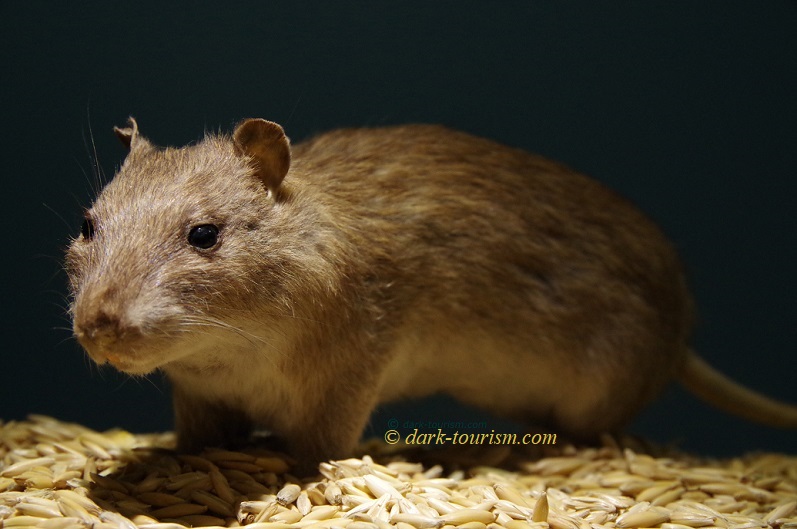
Similarly often vilified are bats, partly for their nocturnal almost soundless flight, their literary association with vampires (and there actually is a subspecies of vampire bats that do drink other animals’ blood!) and, again, for transmitting diseases. The final jury is still out on the case, but it’s well possible that the current coronavirus may have originated in bats. The best bat encounter I ever had on my travels was in the Dominican Republic where I was led into a proper bat cave after having searched out some ancient petroglyphs inside another part of the same cave system (Pomier Caves). There were thousands and thousands of bats, hanging from the cave ceiling or fluttering about because our torch lights disturbed them.
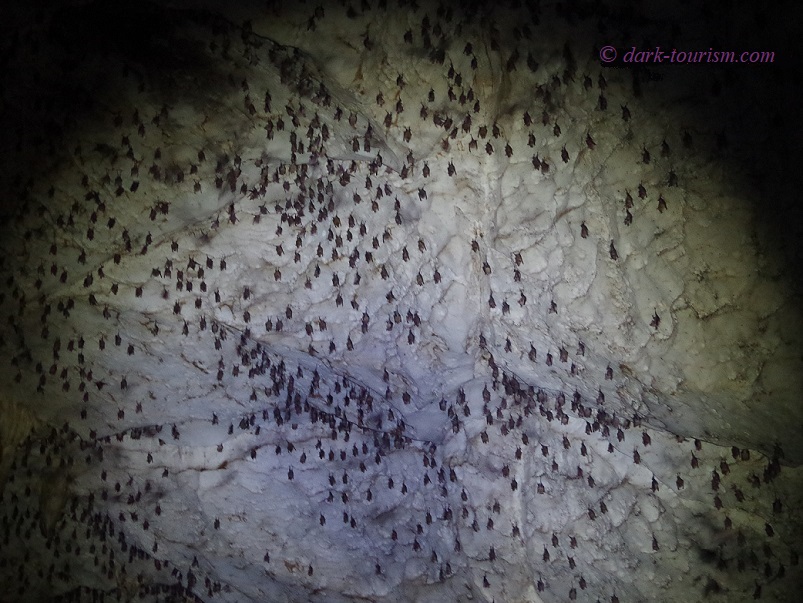
Here’s another photo from that cave, a closer up shot in which you can make out the individuals better, and there’s also one in flight (on the left):
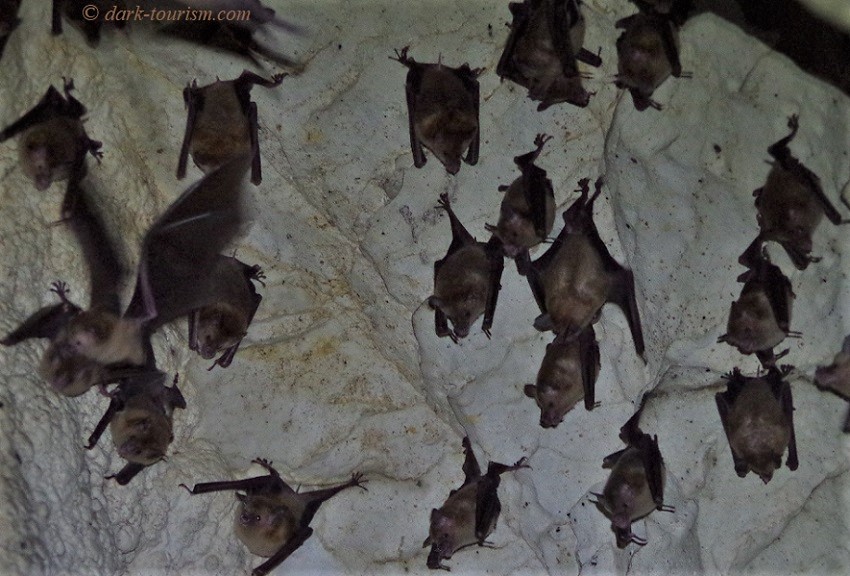
Fascinating as this bat encounter was, it was also pretty dirty – not only because of the cave itself, but also because the disturbed bats overhead showered us with a fine spray with a strong ammonia smell (yes, you guessed right: that was bat piss). So as soon as we had exited the cave, we had to change our clothes. Fortunately we had brought some. (I’ve meanwhile learned that it’s not such a good idea to expose oneself to this kind of encounter, as it does carry the risk of virus transmission, so I would probably not do it again, or certainly not in this manner.)
My second-best bat encounter was in Indonesia, namely coming back by boat from Komodo and Flores (see above under Komodo dragons!). At dusk we anchored near a jungle-clad island without any human settlements, but with a huge colony of giant fruit bats. As night fell they set off in their thousands to fly to neighbouring islands to forage for food there. Watching them gliding past overhead, silently and majestically, was quite a magical experience, and made for some horror-film-esque photos, such as this one:
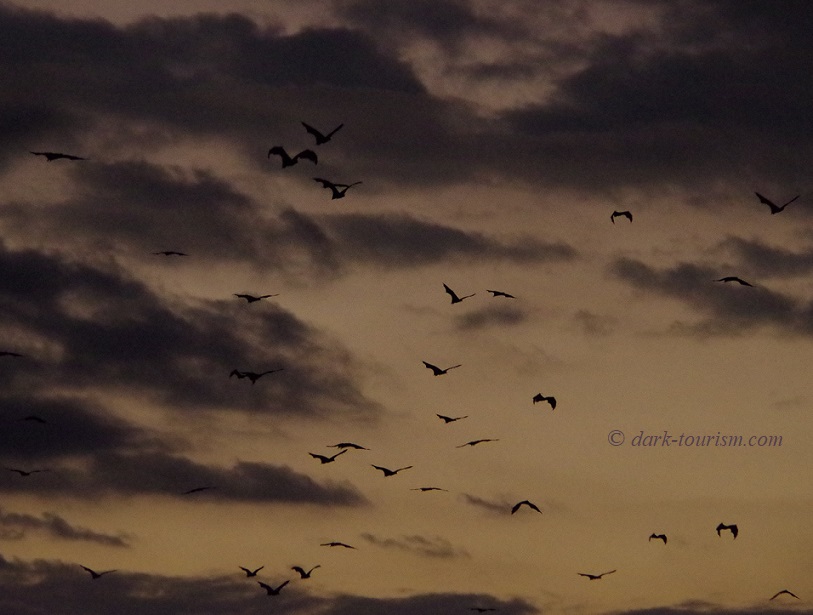
Sometimes the dark aspect associated with an animal species is simply that it is endangered. We all know about the big species poached or hunted to the brink of extinction, such as rhinos or several species of whales. But there are at least as many less spectacular ones similarly endangered. An example is the Hawaiian goose, or nene, which is one of the world’s rarest bird species. Here is a pair I saw drinking from a puddle of rainwater inside Volcanoes National Park in the south of Big Island Hawai’i in 2015:
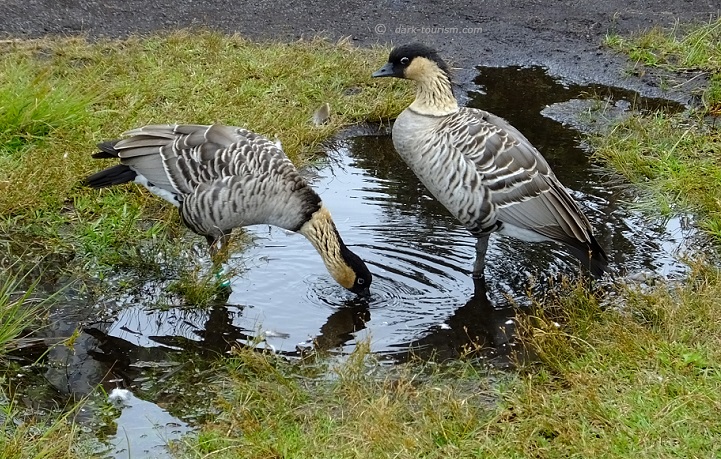
Of my encounters with endangered animals by far the most impressive was meeting a group of mountain gorillas in the Virunga mountains in Rwanda in 2010. I was very lucky: being with a group consisting mostly of Rwandan women who lived in Belgium but were on a visit to their homeland, plus two Japanese women who worked for an NGO in Kigali, so it felt like I was with locals, not tourists. And then we were also lucky that “our” group of gorillas came towards us from higher up in the mountains, sparing us a more strenuous uphill hike. Moreover, the group was just settling down in a clearing to have a break from moving about, so they were just relaxing right in front of us in clear sight for almost a whole hour (which passed so quickly that it felt like just a few minutes). Most impressive was, naturally, the huge silverback male, but the babies were also entertaining, and unbelievably cute.

There is of course also a dark story attached to these mountain gorillas beyond their being endangered, namely that of Dian Fossey, the conservationist of Gorillas in the Mist fame, who did pioneering fieldwork on mountain gorillas but was murdered in her research station of Karisoke in 1985. I also made the pilgrimage to that place where there is also her grave next to those of some of “her” gorillas.
A more recent encounter with an endearing but endangered animal species was in Guyana in the summer of 2019: giant otters. I stayed at Karanambu Lodge, once home to Diane McTurk, the late conservationist who was to giant otters what Dian Fossey had been to mountain gorillas. Now other family members of the McTurks have taken over the lodge and more recently reintroduced the practice of rearing orphaned giant otters at the site. At the time of my visit they had two juvenile individuals who were wonderful to watch. They are such playful and agile creatures. At feeding time, though, they showed their full voraciousness: they grab the piranha fish they’re given with their front paws and then chisel the fish down from the head. It takes them only a few seconds per fish to devour them. They use a lot of energy, so they clearly need a lot of “fuel”.
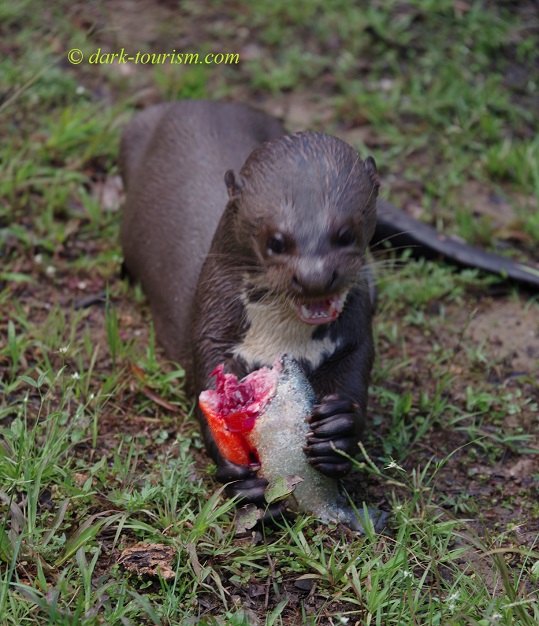
The fact that a species is endangered is more often than not caused by humans; but even if it doesn’t lead to (near) extinction, animals are also often victims of human cruelty. One case is/was the brutal slaughtering of white seal pups in the Arctic, killed for their fur. This is depicted in a life-size display at the Polar Museum in Tromsø, northern Norway:
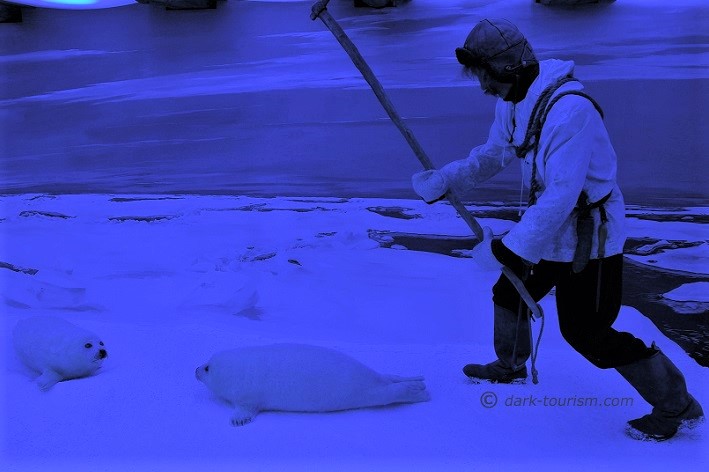
Animals were also used as guinea pigs in nuclear testing, e.g. at the Polygon, aka Semipalatinsk Test Site, in the former Soviet Union, now located in independent Kazakhstan. Here pigs were amongst the animals placed within the nuclear explosions’ paths, apparently to study burn effects, as pigs have a sort of skin that is relatively similar to human skin. At the Museum of the STS in Kurchatov just outside the Polygon there is this jar with a scorched pig’s head preserved in formaldehyde amongst the exhibits:
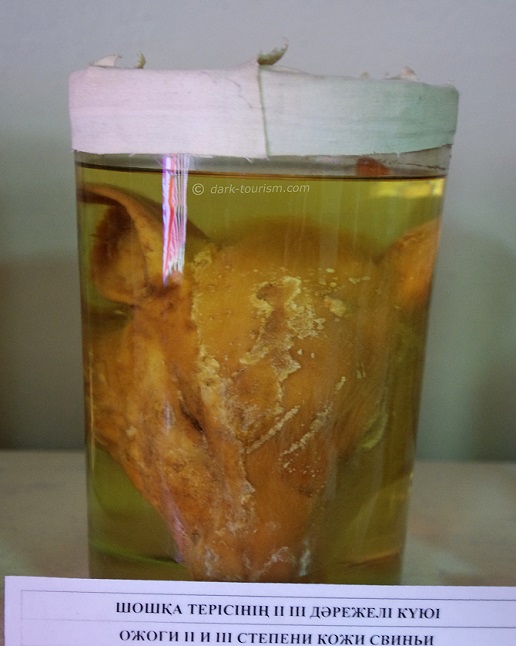
Many animals are also used in various sorts of medical experiments, in this case even two animals, literally “jointly”; this is the “double dog” on display in the Paul Stradins Museum of the History of Medicine in Riga, Latvia:

This is the outcome of a real Frankenstein-like “experiment” conducted in Soviet times. They surgically severed the head and front part off one dog, whilst keeping it alive with all manner of apparatus, then transplanted him onto another, bigger dog, connecting the transplanted dog to the “host” dog’s bloodstream and nervous system. It actually “worked” – to a degree … for a short while. That is: they managed to keep this double canine Frankenstein creation alive for some time. But then the inevitable rejection reactions naturally put an end to it, i.e. to both dogs’ lives. The dead one-and-a-half dog(s) was then stuffed and later put on display in this museum.
From a purely medical science point of view it is indeed quite fascinating that this sort of procedure could actually have been done, but of course for anybody with even the slightest concern for animal rights and welfare, this will more likely be seen as a most dubious and obnoxious abomination of science. I find myself somewhere in the middle … fascinated and appalled at the same time.
Sometimes a photo of an animal is only dark because of the setting it’s in, such as with this cow in Cambodia lazing in the grass in front of a sign informing about landmine clearing operations (in this case with German funding).
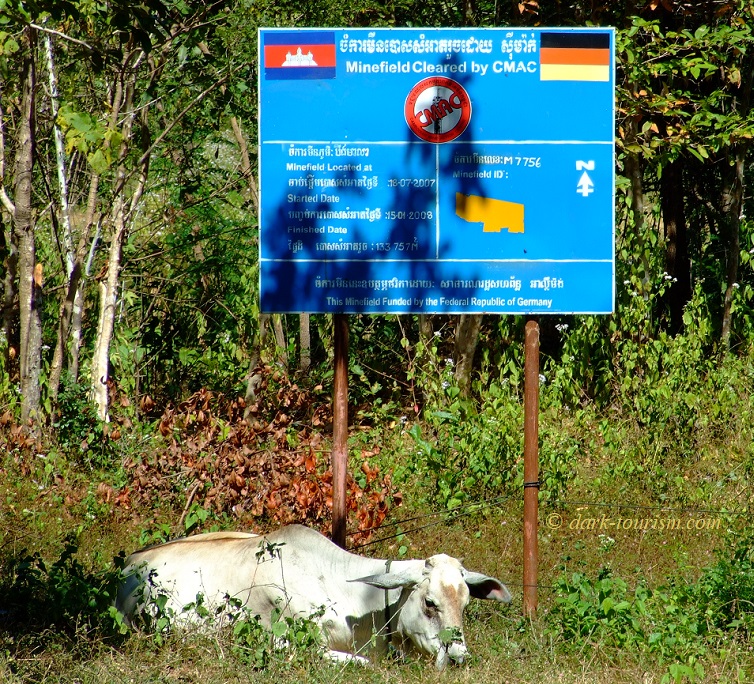
Landmines still maim or kill people in many parts of the world, not just Cambodia, also Vietnam and some African countries like Angola. I can imagine many a cow is also lost to these evil contraptions so maybe this cow is just worshipping the mine-clearers 😉 .
Here’s a similar juxtaposition of a cow and a dark setting, this time the cow is in front of a mural by the road between Chennai and Tranquebar in Tamil Nadu, India, depicting the 2004 Indian Ocean tsunami, which hit south-eastern India hard.
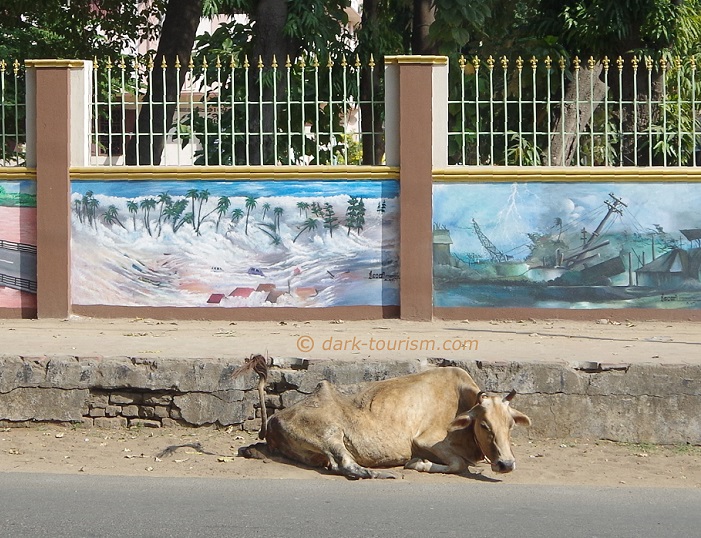
Sri Lanka, the island nation to the south of India was hit by the 2004 tsunami even worse (second worst of all after Indonesia). When I visited that country back in 2006/7 I saw a tsunami monument next to the ruin of a house that had been a lodge; but the tsunami totally wrecked it so only foundations and remnants of a bathroom remained. That was in Yala National Park near the southern tip of the island. And this photo was also taken there:
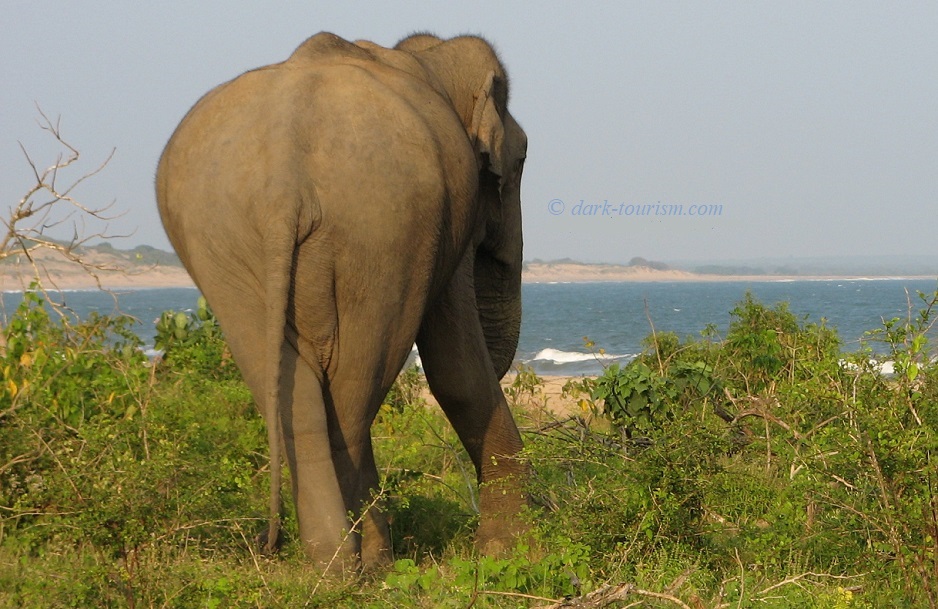
This elephant looks rather wobbly, as if inebriated or trying to stay upright during an earthquake. But it was perfectly calm at the time, so I have no idea why this elephant assumed this strange posture.
And finally we come to a place that has been characterized as one where “dark tourism meets cute tourism”, namely Okunoshima island in Japan, aka “Rabbit Island”, due to the hundreds of feral rabbits that roam the little island … and that’s of course the cute bit. Tourists, mainly domestic, but also a few foreigners, flock to the island to enjoy this mass of rabbits and feed and pet them (as far as the latter is possible, most are too skittish for that). The dark bit about Okunoshima, on the other hand, is that during WWII there used to be a secret poison gas factory on this island, and some traces/ruins of this can still be found here today. And in 1988 a privately initiated, topical museum about the poison gas production was opened near the island’s tourist hotel. But to finish this post I instead give you one of those cute rabbits. I made a point of getting down to their level, i.e. right down to ground level, for this photo – and I believe it really paid off:





2 responses
Long rant short: visit dark tourism sites, it will make you a better tourist and a more compassionate person. t should be noted war tourism can also refer to tourism to active war zones, which is very different! We do NOT condone this form of war tourism, nor do we consider it to be dark tourism.**
neither does my main website condone war tourism – as is made clear in this section: https://www.dark-tourism.com/index.php/darktourism/18-main-menus/mainmenussubpages/607-danger-tourism